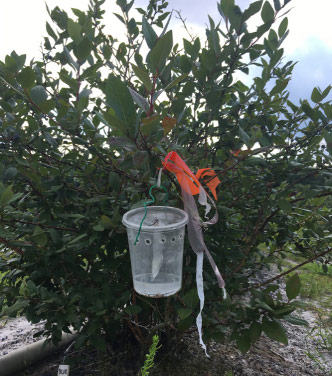Interpreting Trap Captures of Spotted-Wing Drosophila (SWD) in Blueberries
by Cesar Rodriguez-Saona, Rutgers P.E. Marucci Center for Blueberry & Cranberry Research
Although we are making progress in other aspects of IPM such as cultural, behavioral, and biological control, current recommendations to manage SWD rely heavily on preventive weekly applications of broad-spectrum insecticides, including organophosphates, carbamates, and pyrethroids, in rotation. Because a single infested fruit can cause the rejection of an entire shipment, there is a zero tolerance threshold for SWD larvae in fresh market fruit or frozen products. Thus, early detection of adult activity in crops is critical to reduce fruit infestation risks. In New Jersey, monitoring traps are used to detect early fly activity and time the start of insecticide applications (Figure 1). However, the possibility of using trap counts to evaluate the effectiveness of SWD management programs and for predicting fruit infestation in blueberries has thus far remained an open question.

At the Blueberry and Cranberry Research Center, we conducted studies in 2016 and 2017 to determine if: 1) the frequency of insecticide sprays reduce SWD trap count, 2) proximity to forest edges increase SWD trap counts, and 3) trap counts are correlated with fruit infestation. Using a mark-release-recapture study, we also investigated the range of attraction of these traps. Our data showed that: First, insecticide applications reduced SWD trap counts. However, the effect of insecticide applications on trap counts depended on time of the year (i.e., seasonality). Second, trap location matters such that traps placed near non-crop forest habitats within farms had higher SWD counts than those placed in farm interiors. Third, trap counts correlated with fruit infestation since fields with zero fruit infestation had predictably lower trap counts than those with infested fruit. Finally, we found that the maximum dispersive distance for SWD within blueberry fields was 90 m.
Altogether, our data indicate that, under certain circumstances, monitoring traps for SWD can predict the efficacy of management programs in blueberries but, because of high seasonal variability, their predictive power may not be very reliable. Although trap counts could also predict fruit infestation, this prediction was more accurate under a relatively low population size. Based on our data, proximity to forest was the most reliable predictor of high SWD numbers in traps, suggesting a constant pressure of flies moving from non-crop forest habitats into blueberry fields. Our dispersal data were consistent with those previously reported and could be used for future monitoring and management recommendations, such as establishing trap densities or for border spray tactics. Although significant progress has been made in improving current trapping systems for SWD, our study highlights the challenges of developing action thresholds and making management decisions based on trap counts for an invasive pest that has a zero tolerance for larval infestation in crops such as blueberries.
This work was recently published in the Journal of Economic Entomology (“Interpreting Temporal and Spatial Variation in Spotted-Wing Drosophila (Diptera: Drosophilidae) Trap Captures in Highbush Blueberries” by Cesar Rodriguez-Saona, Nicolas Firbas, Johnattan Hernández-Cumplido, Robert Holdcraft, Caryn Michel, Sirley Palacios-Castro, and Diego B. Silva), and was funded by the USDA-NIFA Specialty Crops Research Initiative Award 2015-51181-24252 and the NJ Blueberry/Cranberry Research Council.
